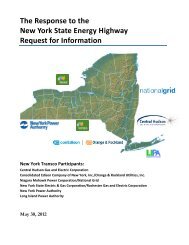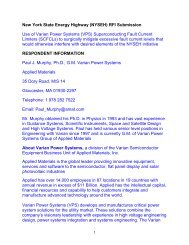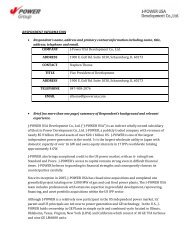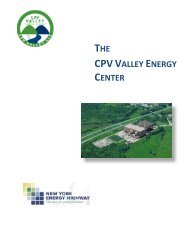Silicon Solution Joint Venture, LLC - Energy Highway
Silicon Solution Joint Venture, LLC - Energy Highway
Silicon Solution Joint Venture, LLC - Energy Highway
Create successful ePaper yourself
Turn your PDF publications into a flip-book with our unique Google optimized e-Paper software.
US SOLAR – WHITE PAPER 24 May 2012<br />
host to exploit the tax benefits directly. This is possible for some corporates such as big box<br />
retailers or even individual homeowners; either may face sufficiently high income tax<br />
obligations to effectively monetise the benefits.<br />
Figure 8: Utility-scale PPA model<br />
Figure 9: Host-owned<br />
sources of finance<br />
Cash flows<br />
Developer<br />
Builds<br />
project/<br />
sponsor<br />
equity<br />
Debt<br />
Lender<br />
Project<br />
Interest<br />
payments<br />
Tax<br />
equity<br />
Tax equity<br />
investor<br />
Tax benefits<br />
Cash flow<br />
Builds<br />
project<br />
Electricity/<br />
tax benefits<br />
Installer<br />
Project<br />
Host<br />
Installation<br />
fees<br />
Electricity/<br />
RECs via PPA<br />
Sale<br />
payments<br />
Electricity in excess<br />
of host use<br />
Excess generation<br />
credit<br />
Utility<br />
Utility<br />
net metering<br />
sources of revenue<br />
Source: Bloomberg New <strong>Energy</strong> Finance Note: RECs are “renewable energy credits”. A PPA is a “power purchase agreement”. For consistency,<br />
Figure 9 characterises the solar asset as a ‘project’, though in residential applications the industry commonly labels it a ‘system’. For a more<br />
extensive explanation of the allocation of tax benefits and cash flows under tax equity structures, see Bloomberg New <strong>Energy</strong> Finance whitepaper<br />
(commissioned by Reznick Group), The return – and returns – of tax equity for US renewable projects, 21 November 2011.<br />
Third-party financing<br />
models offer customers<br />
the benefit of a solar<br />
system without the<br />
upfront cost<br />
However, many residential and commercial users cannot afford the upfront cost of a solar system,<br />
or are unwilling to use their own equity and arrange project debt. This has led to the development<br />
of third-party financing models, which offer customers the benefits of a solar system without the<br />
upfront cost. A host pays to the third-party financier either a series of payments via a lease<br />
($/month) or PPA payments linked to the system's performance ($/kWh), usually based on a 10–<br />
25 year contract. Effectively, the lease/PPA is a loan agreement between the customer and the<br />
third-party financier. Various third-party financiers have developed several different 'flavours' of<br />
this business model: the vertical, semi-vertical and financial market structures.<br />
Vertical model<br />
Third-party financiers<br />
pool multiple leases and<br />
PPAs from multiple<br />
systems to attract larger<br />
project finance lenders<br />
and tax equity providers<br />
Under the vertical model (Figure 10), an integrated player handles customer origination,<br />
installation, engineering, maintenance and financing services via a lease or a PPA tailored to a<br />
customer's location and system size. Such firms essentially serve as both installer and third-party<br />
financier to the home or business owner that receives generation from the PV system. SolarCity is<br />
today among the largest and best-known firms serving this dual role of installer and third-party<br />
financier. Others serve only the third-party role.<br />
Third-party financiers pool multiple leases and PPAs from multiple systems into investment<br />
portfolios to attract larger outside project finance lenders and tax equity providers, which invest in<br />
the portfolio rather than directly in the third party. The third party and the investor create a fund –<br />
which may or may not be leveraged by a lender – to support these projects and build additional<br />
ones. As the third party installs more systems, the fund is drawn down. A host's lease/PPA<br />
payments, though written to the third party, are typically assigned to the fund.<br />
© Bloomberg New <strong>Energy</strong> Finance 2012<br />
Strictly no copying, forwarding, shared passwords or redistribution allowed without prior written permission<br />
of Bloomberg New <strong>Energy</strong> Finance. For more information on terms of use, please contact<br />
sales.bnef@bloomberg.net. Copyright and Disclaimer notice on page 28 applies throughout. Page 7 of 28














